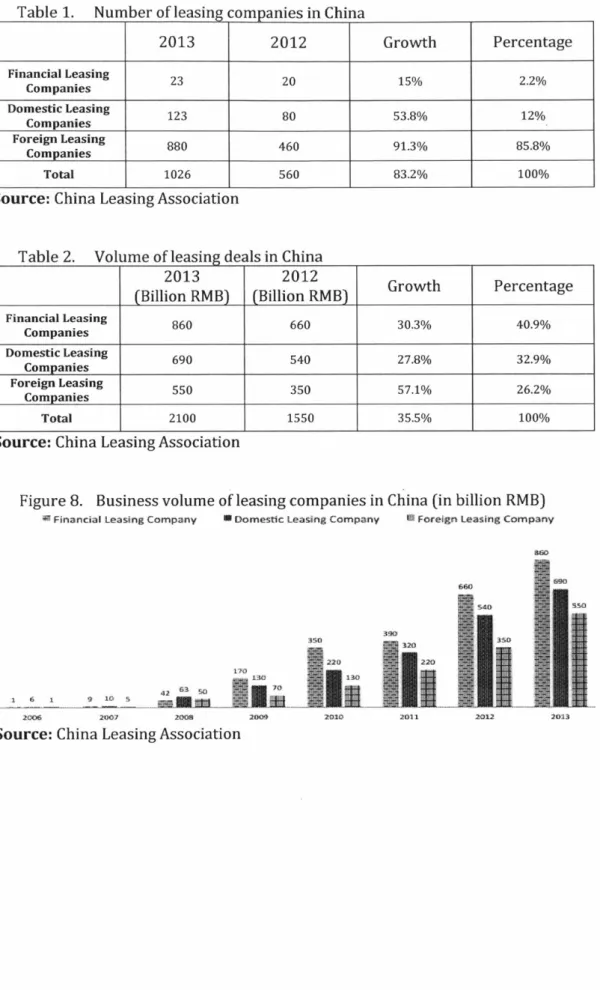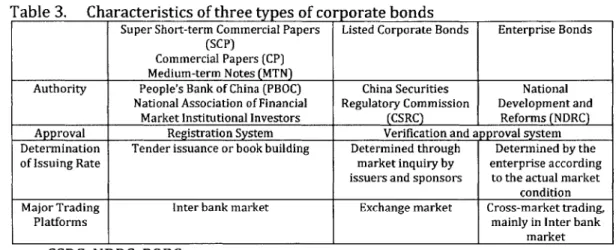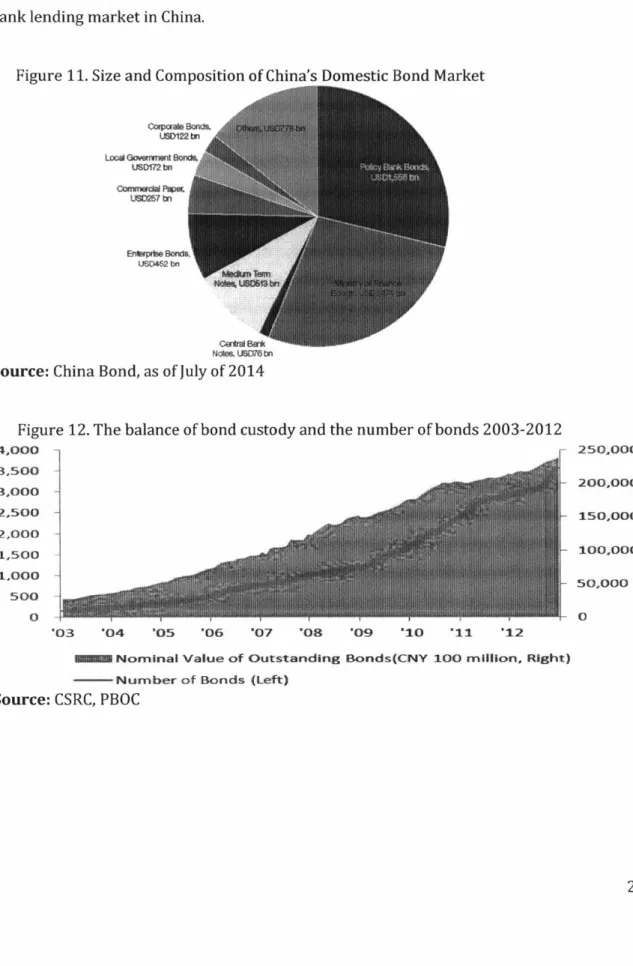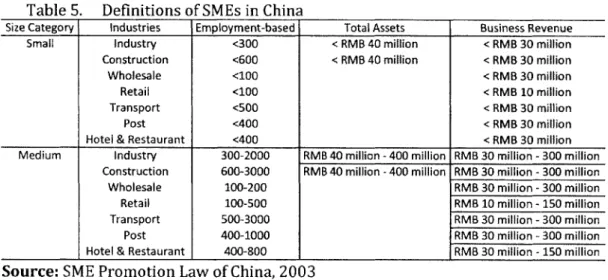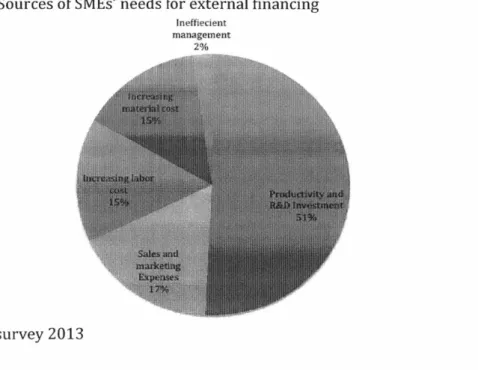Analysis Study of Chinese SMEs Financing Challenges
By
Qiang Zhang B.E. Electronic Engineering
Tsinghua University, 2010
SUBMITTED TO THE MIT SLOAN SCHOOL OF MANAGEMENT IN PARTIAL FULFILLMENT OF THE REQUIREMENTS FOR THE DEGREE OF
ARCHNVES
MASTER OF SCIENCE IN MANAGEMENT STUDIES MASSACHUSETTS (NSTITUTE
AT THE OF TECHNOLOLGY
MASSACHUSETTS INSTITUTE OF TECHNOLOGY
JUN 2 4 2015
JUNE 2015LIBRARIES
@2015 Qiang Zhang. All rights reserved.
The author hereby grants to MIT permission to reproduce and to distribute publicly paper and electronic copies of this thesis document in
whole or in part in any medium now known or hereafter created.
Signature of Author:
Signature red acted
MIT Sloan School of Management May 8, 2015
Certified by:
Signature redacted
ajkamaHyer sociate P fessor of Finance Thesis Supervisor
Accepted by:
Signature redacted
Michael A. Cusumano SMR Distinguished Professor of Management Program Director, M.S. in Management Studies Program MIT Sloan School of Management
Analysis Study of Chinese SMEs Financing Challenges
ByQiang Zhang
Submitted to MIT Sloan School of Management on May 8, 2015 in Partial Fulfillment of the requirements for the Degree of Master of Science in
Management Studies. ABSTRACT
Financing small and medium size enterprises (SMEs) is a prevalent challenge for most of countries, especially developing countries. Chinese SMEs have been suffering from difficulty in financing themselves for long. This thesis presents an overview of China's financial system development and current status and explains different financing sources for SMEs in China. Basing on the understanding of China's financial landscape, I described and summarized the financing challenges that are faced by Chinese SMEs and analyzed both the fundamental and temporary causes behind the challenges. In the end, I proposed a number of solutions to cope with Chinese SMEs financing challenges. Both statistical data and empirical studies are introduced in the thesis for demonstration and analysis.
Thesis Supervisor: Rajkamal lyer
Acknowledgements
To honorable Professor Rajkamal lyer and Professor Michael A. Cusumano For their invaluable academic guidance and enlightenment
To MSMS Classmates For their support and care for me
To my dearest family
Contents
1. Executive Sum m ary
...
8
2. China's financial system
...
9
2.1 Banking system
...
9
2.2 Other financial institutions
...
14
2.2.1 Trust com panies
...
14
2.2.2 Financial leasing com panies
...
16
2.3 Capital m arket
...
19
2.4 Inform al financial sector
...
25
2.4.1 Private Equity and Venture Capital
...
25
2.4.2 Private lending
...
27
3. SM Es in China
...
28
3.1 History of SM Es developm ent in China
...
29
3.2 Challenges for SM Es
...
31
4. The Sources of Financing for SM Es in China
...
34
4.1 Banks
...
34
4.2 Other financial interm ediaries
...
37
4.3 Capital m arkets
...
39
4.4 PE & VC
...
42
4.5 Private credit lending
...
45
5. SM E Financing challenges and Causes
...
47
5.1 Challenges
...
47
5.2 Causes
...
49
5.2.1 Long-term fundam ental reasons
...
49
5.2.2 Tem porary causes
...
52
6. Proposed solutions
...
55
1. Executive Summary
With its GDP growth averaging approximately 10 percent a year for more than 10 years, China is undisputedly regarded as the most dynamic economy in the world and has already became the second largest. As the economy grows, the Chinese financial system has gone through a process of reform and development that not only aligns with the need to finance the fast-growing economy, but also fulfill Chinese government's control and influence over the economy. Numerous studies and researches into Chinese financial system have been carried out, and the topics have been widely various, ranging from the efficiency analysis of the capital market to the study of financial system reliability. This thesis intends to probe into one specific defect that has always been complained about the Chinese financial system: predicament of Small and Medium Enterprises (SMEs) financing in China.
SMEs have always played an important role in the Chinese economy, contributing more than 60% of the country's GDP and more than 70% of employment opportunities. However, comparing to other economic entities such as state-owned enterprises (SOEs), most of SMEs would find it extraordinarily difficult to fund their businesses for continuous operation and growth under the current Chinese financial system. These financing challenges have consequently leaded to severe lack of robustness and innovation among SMEs, which has put SMEs in financially risky positions and therefore hinders both the steady operation of financial system and the sustainably fast growth of economy. In order to help understand the background of SEMs financing, the first part of the thesis will describe the overall landscape of Chinese financial system, which mainly consists of banking system, non-banking financial institutions, capital markets and informal financial sector. Then the thesis will describe the development and current challenges of SEMs in China. For the third part, how SMEs are practically financed through various financing sources will be presented and explained. Based these studies, the thesis will then devote into summarizing and analyzing the causes of Chinese SMEs financing challenges, from the perspectives of both the long-term fundamental reasons and the temporary causes. And then the thesis concludes with a set of proposal to solve the issue.
2.
China's
financial system
In order to gain a thorough and precise analysis of SMEs financing in China, we find it essential to firstly have a brief and clear understanding of the Chinese financial system, especially the financial institutions that involve in SMEs financing activities. Therefore this part will respectively introduce the development history and current status of major sectors of the Chinese financial system.
2.1 Banking system
On December 1st 1948, People's Bank of China (PBOC) was officially set up by the central government of China, signaling the starting of China's financial system buildup. As the only financial institution that was allowed to practice banking businesses, PBOC functioned as both a central bank and a commercial bank, serving all the financial and fiscal duties of China's planned economy till the end of 1970s.
In 1978, as Deng Xiaoping stepped up onto the top of China's political system and decided that economic openness and reform is the right direction of China's future, the economy started to transform from central plan based to market based and the Chinese financial system started a series of significant reforms at the same time. The reforms started from the banking system. Between 1979 and 1984, four state-owned commercial banks (Bank of China, Agricultural Bank of China, People's Construction Bank of China, Industrial and Commercial Bank of China) were successively established, respectively focusing on different sections of commercial banking businesses. These four state-owned commercial banks later grew to be the most dominant players in the Chinese banking industry and were known as the "Big Four". The Big Four gradually took over and split up the commercial banking businesses that were originally practiced by PBOC. Thus, PBOC would exit the commercial banking business and focus on its role of central bank ever since. The Big Four were directed to deal with different sectors of banking businesses respectively and were supposed to avoid any competition among them in the beginning. Then in 1984, central bank PBOC decides to allow the Big Four to expand their service sectors and compete for business, which leads the Big Four to engage in providing loans to fund the
dynamically growing businesses of community-owned SMEs. Thus, China managed to form its initial financial system, which essentially is a banking system still with certain level of planned economy characteristics, consisted of a national central bank and four large commercial banks that are owned and controlled by the central government.
As reform and openness of economy continued and escalated, more incentives were created for further development of the banking industry. In 1987, PBOC brought forward the proposal of forming a socialistic financial system that is led by PBOC and composed of various types of financial institutions, especially various types of banks. As the leaders of reform envisioned, commercial banks were expected to function more as enterprises than as government departments. However, the Big Four often found it contradictory to both provide policy-type credit loans following government orders and commercial credit loans following market choices. Consequently, three state-owned policy banks that specialize in policy-type credit loan business were successively established in 1994: the Agricultural Development Bank of China, the Export-Import Bank of China, and the China Development Bank. These policy banks were responsible for funding state-led development projects ever since, leaving Big Four gradually evolve into pure commercial banks that solely owned by the state and managed as independent enterprises. Almost during the same period of time, many other types of banks came to stage and joined the economic reform and development. In 1986, the fifth largest commercial bank was formed: the Communication Bank of China, in the form of join-stock entity. And 12 more join-stock commercial banks were set up in succession afterwards. At the end of 1996, the Big Four state-owned commercial banks consisted of around 153,000 branches and more than 1,680,000 employees, while the 13 join-stock commercial banks together had 3,750 branches and more than 85,000 employees. During the same period of time from 1986 to 1996, postal savings bank was set up as an additional specific type of financial institutes, intending to collect deposits and use the money to help fund economic growth. And in 1995, the first municipal commercial bank emerged in China: Shen Zhen Commercial Bank. 18 more municipal commercial banks were formed before the end of 1996. Thus, China achieved setting up an early stage banking system that is dominated by the Big Four and includes various types of banks that geographically covered different markets. Nevertheless, the extensive establishments
banks with multi sizes and functions did not necessarily equal to a market based mechanism of the banking system. Issues like agency problems were extraordinarily severe in the Chinese banks, mostly due to the very fundamental fact that the government dominantly owned the banks and often went against the market mechanism by giving banks fixed quotas for the amount of deposits and loans or by forcing banks to provide funding for specific state-owned enterprises and local development projects. For example, in late 1980s and early 1990s, local governments could directly appoint local branch managers of state-owned commercial banks. This means that local governments had easy and unreasonable access to bank loans, which together with local governments' preference of aggressive economic growth led to a rapid credit and inflation growth.
Since 2002, as China joined the World Trade Organization (WTO) and the economic contribution from private sectors became increasingly influential, a more open and market-based banking system were urgently needed. So foreign banks started to provide specific services in Chinese market and competed with Chinese banks. The competition from foreign banks also to some extent stimulated further improvement of Big Four and other Chinese commercial banks. In the meanwhile, as the banking system became much more comprehensive and complicated, systematic risks of financial sector accumulated further more. In face of such challenges, the Chinese government found it necessary to further strengthen supervision and regulation of commercial banks, as part of its efforts to advance the reforms of banking industry. Subsequently, China Banking Regulatory Commission (CBRC) was officially formed in 2003, and many modifications of the Law of Commercial Banks were passed to legitimatize CBRC's role of regulating banking industry and making related policies. With a more comprehensive set of financial laws and a better-designed regulatory system, banks started to be managed with higher level of professionalism and financial risk in banking industry significantly decreased. For instance, bad debt rate of major commercial banks fell from 23.5% in 2002 to 6.8% in 2007. Meanwhile, further joint-stock system reform is opposed upon major commercial banks, especially the Big Four. The government intended to make the Big Four develop into most influential and powerful financial institutions so that strong and stable financial support could be guaranteed for the rapid economic development. The Big Four successively became listed
on stock markets both in China mainland and Hong Kong, each of the four gradually becoming one of the largest commercial banks in the world. Lastly, as the overall economy developed, people were much more incentivized to consume than before, which led to the widespread development of banking services in consumption credit loans, in addition to banking services for companies or commercial projects. Together with the vast development of real estate and automobile markets, various types of banking services were provided to individuals, widening and deepening the involvement of banks in the Chinese overall economy. Till now, banking system has undisputedly become the most influential in the Chinese financial system.
Figure 1. Total assets of banks in China from 2003 to 2013 (in trillion RMB)
16--- ---- ---- ---- --- --- ---- --- -_--- --- )--- --- -- --- 151.4 160 ... ... .. ... . ... .... ... . ... ... . .. ... .. .... ... . ... 1133.1 1 2 0 ... .. ... ... ... ... .... ... ... ... ... ... ... ... -.-....--.--....--... 53.1 0 2003 2004 2005 2006 2007 2008 2009 2010 2011 2012 2013 Source: People's Bank of China; CBRC
Figure 2:. Bank deposits in China from 2003 to 2013 (in trillion RMB.
12 0 --- ...-.--- -- - -- -..-- ---... .. --- --- ...- ..-.---...-- 10 7 -0 6
-34.3 41.1
40 -... ... . ....- . .-... ... ...
0
2003 2004 2005 2006 2007 2008 2009 2010 2011 2012 201
Figure 3. Number of foreign banks in China from 2004 to 2013 .... ... .... ---.. -...--..--- - - --- ... -... ... -....-. ..---. --.--. 90 ... I... . . . . . 800 ... 700 7 ... .o 600 ... (D . . . . . . . . . . . . . . . . . . . . ... 412 . . -0 E 400 --- ---...-274 31t-... 300 ...-...- - -.207 .----.-224--- - .... -200 .--. -. 100 -0 2004 2005 2006 2007 2008 2009 2010 2011 2012 2013 Source: CBRC
Figure 4. Financial system structure in comparison, 2013
United States Inida Brazil Korea,Rep. Japan Russian Federation China
~aumu$~4~~
II
Stock market cap
11 Government bonds
OL Nongovernment bonds - Bank credit
0% 20% 40% 60% 80% 100%
Source: CSRC, CBRC, BIS, IMF, World Bank, World Development Indicators
Figure 5. Share of selected bankgroups in China in the total balance in 2013
0.0%
State banks private commercial banks Development banks City banks
Rural credit cooperatives
Postbank
Rural commercial banks
Non-bank financial institutions Foreign banks
Rural genobanks
Urban credit cooperative
10.0%
Share in total assets in percent
20.0% 30.0% 40.0% 14.96?%
-
8.82% S7.21 % 6.97% 3.43% 2.37% 1.97% 1.71% 1.62% 0.03% Source: CBRC 50.0% 60.0% 50.89%!__." 1 -1 ;Kle
I
. -
. ITrust companies have gone through many major reforms and significant changes within its history in China since 1979. Chinese government has reshaped the role and positioning of trust companies for several times, in order to support the developing financial system that is absolutely dominated by major banks and accompanied by other financial intermediates as well. In short, trust companies in China are not exactly equal to trust companies that are normally seen in the western world. Commonly in China, trust companies are referred to as trust banks and investment companies that participate in a certain range of financial services, not only restricted to how the term trust is applied in the west. As China applies a financial system that is separately operated and supervised, trust companies are the only financial institutions that are allowed to participate in money market, capital market and direct investment. This gives trust companies obvious advantages in involving in various types of financial services and deals, therefore trust companies in China are very opportunistic in nature, always adjusting to the changes of regulatory policies and rolling out new services in response to market changes.
The start of China's trust companies dated back to October of year 1979, when China International Trust & Investment Company (CITIC) was formed. CITIC was formed under Deng Xiaoping's request of setting up a financial company that helps Chinese companies attract foreign investments. In the middle of the following year, PBOC issued the notice of actively promoting and establishing trust businesses in China. As a result, 241 branches of banks across 21 provinces set up trust companies and started trust businesses before the end of the year. Later on, non-financial institutions also joint in setting up trust companies. As trust sector expanded unruly ever since, there were around 620 such trust entities by the end of year 1982. One of the major reasons behind the fast expansion was central government's lack of clear and systematic regulation and laws on the trust sector development. Since trust companies were simply regarded by the government as a supplement channel of financing to the banking system where there was still strong governmental control of lending through banking system, large amount of lending was
realized through the utilization of trust companies, and most of the lending goes to the enterprises and investment projects owned by the local governments that were overly motivated to boost economic growth. Meanwhile, as trust companies could participate across money market, capital market and direct investments, a lot of opportunistic practices and speculative behavior in lending market and security market were carried out through trust companies. With a lack of clear development direction and insufficient risk control ability, trust companies took large amount of non-performing asset and some went bankrupt. In 2000, the International Monetary Fund estimated that the debt of Chinese trust and investment companies totaled between 12 billion USD and 20 billion USD. Thus, five times of major regulation and reorganization of trust sector were performed between year 1980 and 2000, defining business boundaries and eliminating unqualified players. Before the Trust Law was put into practice in 2001, only 68 trust companies still remained their existence in China. To summarize, as a pioneer of China's financial reform, trust companies have been actively trying businesses that are market-oriented but not regulated
by the government yet, thus trust companies' ever-changing practices gradually stimulated
the overall regulation and reform of the financial system. While blocking and restructuring the trust sector between 2001 and 2007, the government also set up and applied a series of rules and laws that classify, supervise and regulate trust businesses. This ever-developing legal system placed a solid foundation for the rapid development of trust companies since
2007. The amount of assets managed by China's trust companies grew from 1,200 billion
RMB in year 2007 to 14,000 billion RMB in 2014, with a compound annual growth rate of more than 30%. Realized operational income in 2014 reached as high as 95.50 billion RMB, and profit mounted to be 64.23 billion RMB. Currently, trust companies mainly involve in two areas: to put the money and other assets entrusted by individual and institutional clients (mainly commercial banks) into various types of investments; to invest in financial institutions' equity or financial products with trust companies' own principal capital. As economy grows and trust companies participate more actively in financial services, the first area becomes the dominant source of income for trust companies. Especially with the financing need of SMEs and local governments' infrastructure investment not satisfying by commercial banks, trust companies became a major component of a China's vast shadow
banking. The trust funds could be classified based on different industries where the investments go into.
Figure 6. Trust company assets in China
on'Trust assets under management mGrowth vs. previous year
80% YoY 12 trillion yuan
60 .9
40 6
00
2011 2012 2013
Source: China Trustee Association
Figure 7. Industry breakdown of trust product issuance
100% -asI _ 609r 50% oi 4096 3096. 2096 1096 -201001 2010 02 2010 03 201004 201101 2011 02 2011 03 2011 04 201201
Finaricial sector MM Real estate El Industry It Jnfrastructure NaK Other Source: China Trustee Association
2.2.2 Financial leasing companies
Financial leasing is a financial agreement under which an asset or property is purchased by the lessor from the supplier at the request from the lessee and provides the uses of this asset or property to the lessee against payment of a leasing fee. The start of leasing industry in China dated back to year 1981, when China Orient Leasing Company Limited was formed. From 1988 to 1998, a series of defaults in leasing companies led to a sluggish development of the industry. The following application of several leasing related laws and
regulations, together with the vast increase in export trades due to joining WTO since 2001, has not only created a fast-growing market need for leasing services, but also brought in a number of foreign leasing companies that contributed in the optimization of China's leasing industry structure. In 2007, CBRC issued Measures for the Administration of Finance Leasing Companies, allowing and encouraging Chinese commercial banks to set up financial leasing companies. With advantage of easy access to loans and shared client groups provided by their parental commercial banks, these financial leasing companies grew at a much faster pace than normal leasing companies and foreign leasing companies. The annual leasing volume of these financial leasing companies increased from 9 billion RMB in 2007 to 860 billion RMB in 2013. One of the forces that stimulated such a fast growth was the 4 trillion RMB investment plan in 2008, which encouraged investment in infrastructure and heavy industry and thus led to high demanding of equipment leasing. The number of all three types of leasing companies in total increased from 93 in 2007 to
1026 in 2013, among which the number of foreign leasing companies grows fastest due to
their fast and convenient approval of establishment. While there are only 23 financial leasing companies at the end of 2013, their assets compose 80% of the assets of the whole leasing industry. Financial leasing companies, which are frequently referred to as bank lessors, have become the leading player, while captive lessors and third party lessors are placed at the second and the third. Bank lessors and most of large foreign captive lessors mostly focused on serving large companies (especially state owned enterprises and multinational corporations) with an average deal volume of more than 100 million RMB, while third party lessors (both domestic and foreign included) are almost the only suppliers of leasing services to SMEs in China. In recent years, Ministry of Commerce and CBRC, two regulatory bodies of China's leasing industry are taking increasingly positive initiatives to make leasing more accessible to SMEs.
Table 1. Number of leasing companies in China 2013 2012 Growth Percentage Financial Leasing 23 20 15% 2.2% Companies Domestic Leasing 123 80 53.8% 12% Companies Foreign Leasing 880 460 91.3% 85.8% Companies Total 1026 560 83.2% 100%
Source: China Leasing Association
Table 2. Volume of leasing deals in China
2013 2012 Growth Percentage (Billion RMB) (Billion RMB) Financial Leasing 860 660 30.3% 40.9% Companies Domestic Leasing 690 540 27.8% 32.9% Companies Foreign Leasing 550 350 57.1% 26.2% Companies Total 2100 1550 35.5% 100%
Source: China Leasing Association
Figure 8. Business volume of leasing companies in China (in billion RMB)
43 Financial Leasing Company 0 Domestic Leasing Company * Foreign Leasing Company
42 63 SO
1 6 1 9 10 S
20C" 2007 2003
Source: China Leasing Associatio
660 660 22"0 130 2009 2002011 2012 2013 n
2.3 Capital market
After its decision of economic reform and opening-up policy, China's economy gradually underwent a transformation from a centrally planned economy to a market-oriented one. To support such a sophisticated transformation and to serve a fast-growing financing demand across the nation, central government realized that a financial system constituting of only banks and non-banking financial institutions was not enough. The need of market-oriented financing and the government's consent of experimental trials led to the initial establishment and development of China's capital market in early 1980s.
The development of China's capital market could be mainly divided into three phases.
From 1978 to 1992, China's capital market emerged and went through its early stage of trials and explorations. In 1979, China's reform and opening-up policy started to be implemented. In 1981, initial form of trading of treasury bonds started in China. In 1986, public trading of stock appeared in Shanghai. In 1987, the first professional securities firm in China, Shenzhen Special Zone Securities firms was established, in response to the nationwide expansion of treasury bonds trading. And more securities intermediaries came to emergence afterwards. In 1990 and 1991, tow stock exchanges were opened respectively in Shenzhen and Shanghai. In 1992, a special kind of stocks called B-shares started to be issued for foreign investors on domestic market, in order to attract foreign capital to China. To summarize, the first phase was the period when China's capital market evolved from a number of regional trials and schemes, which was not sufficiently regulated and supervised by a regulatory system. But the goal of Chinese government was to transform SOEs into joint stock companies and allow them to raise funds through capital market.
The second phase is from 1992 to 1999, a period when a nation-wide capital market was formed and further developed, with a more sophisticated system of regulation being developed simultaneously. In 1992, China Securities Regulatory Commission (CSRC) was enacted as the regulator of the national securities market and a centralized regulatory and supervisory framework was gradually formed ever since. In 1997, Chinese government
decided to separate the regulation and supervision of the banking, securities and insurance sectors. Also, a more comprehensive legal framework started its formulation through the effort of CSRC. Between 1993 and 1998, such laws as The Provisional Regulation on Stocks Issuance and Trading were gradually promulgated and implemented. With the presence of CSRC, stocks could then be issued through public offering to all domestic investors. But an approval system that sets quota for the number of stocks to be listed was applied by the CSRC with its intention of preventing possible excessive speculative investment in an immature market by immature domestic investors. Also during this phase, the two stock exchanges continued developed in terms of increasing transaction efficiency, market transparency and information disclosure. During this phase, securities intermediaries grew fast and securities investment funds started to emerge in China. In summary, China's capital market quickly grew into a centralized national market that is supervised under a newly established system of laws and regulations.
From 1999 to 2007, further adjustments to the mechanism and regulatory system of the capital market were implemented to support its fast growth that originated from China's further growth in the volume of exports and domestic investment in infrastructure and real estate industry after joining WTO and further opening up the market. During this period, further efforts were put into the enforcement of regulations and laws in capital market so as to refine the overall system and remain a healthy market environment. The non-tradable stock reform was widely regarded as the most influential advancement in the improvement of efficiency in China's capital market. Also, SME Board and the Share Transfer System were both launched to meet the diversified demands of return and risks of different investors, thus a multi-layered capital market started to form. Meanwhile, development of the bond market was initiated during this phase. The bond market in China is comparatively small in its volume, due to a lack of authentic credit-rating system and overlapping regulations. So the development of the bond market was slow and restricted to the settlement of legal framework and market mechanism. In 2002, Qualified Foreign Institutional Investor (QFII) program was introduced and more foreign capital started flowing into China's capital market. The QFII program has changed the competition landscape in the fund management industry in China. Large SOEs started to be encouraged to raise funds through overseas
listing and issuance. To summarize, more comprehensive developments were executed during this phase, to bring more systematically efficient regulations and more market mechanism to China's capital market.
Figure 9. Market Capitalization of China's stock market (in USD)
2Z im W* im ZM na ee a n
M" 2M nn "
Source: CSRC, World Bank
Figure 10. Total market capitalization and number of listed companies in China
350,000 -- 3,000 300,000 2,494 2,0 250,000 Lo 200,000 1,500 150,000 1,000 100,000 50,00 -1 500 '03 04 '05 '06 07 108 ' 11 10 oil '12
WOWnNTotal Market Cap of SSE & SZSE (CNY 100 million, Left)
---- Number of Listed Companies In SSE & SZSE (Right)
Source: CSRC
Soon after the start of its economic reforms, the Chinese government also started to issue government bonds to finance the reforms and to suppress the inflation that accompanied
the economic growth. As economy continued growing, the issuing size of government bonds also increased, as well as the level of bond market infrastructure development. Two exchange bond markets and the national interbank market were opened in succession, so as to allow the circulation of government bonds in secondary markets and to nurture a market-oriented bond market. With the improvement in issuing and trading system and the introduction of the market pricing mechanism, the government bonds grew
significantly from 4.9 billion RMB in 1981 to 800 billion RMB in 2008. Corporate bonds
started to appear in mid 1980s, when SOEs were allowed to issue corporate bonds (also named as enterprise bonds) in addition to raising funds through bank loans. Without a mature regulatory system in place and with the special agency issue in SOEs, corporate bond issuance quickly became overheated, resulting in a high default rate. So the government almost suspended the issuance of corporate bonds and took measures to strengthen the regulation of the bond markets. From 1995 to 2004, the corporate bonds issuance grew very slowly under strict regulatory system with limited quota given by the government. The size of issuance was small, and the circulation of corporate bonds was also stagnated. With a series of laws and regulations gradually established, issuance of corporate bonds rejuvenated in 2005, when the issuance of corporate short-term bills was encouraged to help enterprises gain access to direct financing. In addition to corporate bonds, financial bonds have also gone through significant development since early 1980s. In 1990s, policy banks were the major issuers of financial bonds, and the size of the issuance is only subject to that of the government bonds. In early 2000s, a certain group of commercial banks and securities companies selected and approved by the government also started to issue bonds to raise capital.
After a quarter of century's development, the bond market in China is now a multi-layered market with three segments: the interbank market, the exchange market and the bank counter market. The interbank market is the larges of the three, taking more than 90% of the overall Chinese bond market volume. Among all the bonds on the market, non-financial
corporate bonds function as an alternative way for corporation in China to raise capital other than by taking loans from commercial banks. Till the end of 2013, the size of corporate bonds takes 44% of the total issuance of Chinese bond market, with an
approximate number of 3.6 trillion RMB. While government bonds and financial bonds take 24% and 32% respectively. There are mainly three types of corporate bonds: Listed Corporate Bonds, Enterprise Bonds, and Short-term Corporate Financing Bills.
Table 3. Characteristics of three types of corporate bonds
Super Short-term Commercial Papers Listed Corporate Bonds Enterprise Bonds (SCP)
Commercial Papers (CP) Medium-term Notes (MTN)
Authority People's Bank of China (PBOC) China Securities National National Association of Financial Regulatory Commission Development and
Market Institutional Investors (CSRC) Reforms (NDRC) Approval Registration System Verification and approval system Determination Tender issuance or book building Determined through Determined by the
of Issuing Rate market inquiry by enterprise according
issuers and sponsors to the actual market condition Major Trading Inter bank market Exchange market Cross-market trading,
Platforms mainly in Inter bank
I _market
Source: CSRC, NDRC, POBC
Among the issuers of corporate bonds, SOEs are dominant players and private companies that are listed play an important role as well. But SMEs are not significant issuers in the market at all. And among the holders of corporate bonds, commercial banks take more than half of the market volume, leaving the rest shared by funds institutions and insurance companies. The development of the Chinese corporate bond market has been substantially stimulated by the government's intention of better meeting the financing needs of SOEs.
Table 4.
Ratio
ofissuance
of coroebnsb sur.i 203SOEs Central SOEs Local SOEs Private Foreign Others Companies Companies SCP 100% 98.6% 1.4% 0.0% 0.0% 0.0% CP 66.2% 21.2% 45.1% 22.2% 7.2% 4.4% MTN 78.2% 16.1% 62.1% 12.6% 6.1% 3.1% Enterprise bonds 94.9% 3.2% 91.7% 3.2% 1.3% 0.5% Listed Corporate 27.3% 7.6% 19.6% 46.6% 6.2% 19.9% bonds
Source: China Bond
The turnover ratios of corporate bonds are also quite low, ranging from 0.6 to 1.2 between
turnover ratio and that SOEs and commercial banks are respectively major issuers and holders of corporate bonds, it is believed that bond market is substantially another form of bank lending market in China.
Figure 11. Size and Composition of China's Domestic Bond Market
USD172 bn
CommuM Ppr,
USD257 bn
USD452 bn
Nok3% US=7 bn
Source: China Bond, as of July of 2014
Figure 12. The balance of bond custody and the number of bonds 2003-2012
4,000 250,000 3,500 3,000 -200,000 2,500 150,000 2,000 1,500 -100,000 1,000 50,000 0 0 '03 '04 '05 '06 '07 l08 .09 '10 'i '12
Nominal Value of Outstanding Bonds(CNY 100 million, Right) -Number of Bonds (Left)
A.4 Informal financial sector
2.4.1 Private EqUity and Venture Capital
Private Equity was also a form of financial vehicle that Chinese government tried to learn from the west and introduce to China as an additional force that provides capital needed for the fast growth of China's economy. Private equity and venture capital are generally regarded as different concepts in the US, as US private equity firms mostly focus on LBOs and the acquisitions of small and medium enterprises while venture capital firms exclusively invest in startups and small firms. This difference of private equity and venture capital is comparatively less apparent in China, for that both private equity and venture capital focus mainly on investing in startups and SMEs that would later get listed on stock markets. There are not enough LBO deals in China for private equity to get into. Private equity and venture capital have been one of the fasted growing financial sectors in the past ten years. Now the sector is packed with larger foreign private equity firms, government-backed firms and small or medium cap firms. The development of private equity and venture capital in China could also be divided into three phases.
From mid 1980s to mid 1990s, private equity industry was gradually introduced and established in China. In 1985, the first venture capital fund in China was set up by the central government with an intention to encourage the development of science and technology. Later on more local governments joined the efforts of establishing technology-based venture capital firms so as to propel regional technical and economic development. The reorganization of SOEs in early 1990s also attracted more formation and participation of private equity firms in China, as well as some foreign private equity firms. As China's legal framework that regulates the market-oriented economy gradually formed, foreign private equity and venture capital funds became more interested in the investment opportunities in China, which was exactly what central government was trying to achieve: attract foreign capital to invest in China.
Since late 1990s, China's private equity and venture capital market picked up its pace significantly. Firstly, due to the release and implementation of a series of laws and
regulations that encouraged both domestic and foreign private equity funds to invest in certain fields such as industrial development projects, more venture capital funds were set up and more industries gained access to venture capital. Chinese political leaders such as Vice Prime Minister Zhu Rongji also pushed for greater expansion of China's private equity and venture capital industry. During this period, government-backed PE and VC funds gradually left the market the private and foreign funds. Secondly, as Internet boom effect came to China, a lot startups in Internet industry are in great need of capital from PE and
VC, since the banking system at that time would not provide financing for such highly risky
small companies. So a lot of such startups tried to seek for funding from PE and VC firms in the U.S. and this turned out to open a window for U.S. PE and VC firms to look into the great investment opportunities in China's Internet industry. So more foreign firms came to China and the VC industry developed fast with the professionalism and practices that these firms brought in.
From 2000 to 2010, more sophisticated regulation system was gradually formed to develop China's stock market into a more stable and healthy one. This not only attracted more capital invested into the stock market, but also made China more attractive to both foreign and domestic PE and VC firms, since a stock market that is regulated under a strong legal structure means a more predictable execution of exit strategy for PE and VC firms. Also, many domestic private equity funds were established to finance small businesses in particular industries like manufacturing, biotechnology and Internet. These domestic funds took a significant advantage over foreign funds by facing less regulatory delay or restrictions imposed by governments. The 2008 global financial crisis put a pause to the development of PE and VC industry due to difficulty in fundraising and exit, especially for foreign firms. However, Central government's 4 trillion RMB stimulation plan re-activated the economy boom, leading to another round of fast growth in PE and VC industry in China. As more capital and more talents jump into the industry, it is widely expected that China's PE and VC sector would continue growing fast both in investment volume and in the diversity of the target industry.
2.4.2 Private lending
Private lending has always been a choice of financing for SMEs, especially when SMEs lack access to bank loans, which happens a lot under the current Chinese banking system. Due to many systematic reasons, many private companies could not acquire financing from either banks or capital market. If more working capital or investment is needed for further business growth for these private firms, entrepreneurs often have no choice but borrow from individuals, who would ask for a higher rate of return than the bank loan interest that is regulated by central bank. On the other hand, since China's stock market has been widely regarded as full of speculation, people don't find it wise to invest in stock market. And such lower risk market as bond market is also very underdeveloped in China. Actually Chinese people don't have many good options for investing their money. Thus, lending money to SMEs is one of the practical choices for individuals. Gradually, some private firms are formed to collect money from individuals and lend the capital to the SMEs in the name of the firm, so as to improve efficiency in finding proper targets and managing the pro-lending
supervision. There is no accurate statics on the volume of such private lending in China, but it is estimated that the number should be around 6 trillion RMB at the end of 2013, which is around 8% of the total amount of loans provided by Chinese banks. Private lending is a significant component of shadow banking in China, taking around 20% to 30% of the total shadow banking volume. Other shadow banking market participants are non-bank financial institutions, such as trust companies, financial leasing companies, brokerage firms and financial guarantors. Private lending has been an indispensable source of financing that has stimulated the growth of private sector in China's economy, especially that of SMEs. It is also a financial sector that is hard to regulate and supervise, thus presenting a risk.
3. SMEs in China
Currently, SMEs are recognized among seven economic sectors - industry, construction, wholesale, retail, transport, post and hotel & restaurant. Generally speaking, companies with sales between RMB 30 million and RMB 300 million with a workforce ranging from
300 to 3000 employees are regarded as SMEs in China.
Table 5. Definitions of SMEs in China
Size category Industries Employment-based Total Assets Business Revenue
Small Industry <300 < RMB 40 million < RMB 30 million
Construction <600 < RMB 40 million < RMB 30 million
Wholesale <100 < RMB 30 million
Retail <100 < RMB 10 million
Transport <500 < RMB 30 million
Post <400 < RMB 30 million
Hotel & Restaurant <400 < RMB 30 million
Medium Industry 300-2000 RMB 40 million -400 million RMB 30 million -300 million
construction 600-3000 RMB 40 million - 400 million RMB 30 million -300 million
Wholesale 100-200 RMB 30 million -300 million
Retail 100-500 RMB 10 million -150 million
Transport 500-3000 RMB 30 million -300 million
Post 400-1000 RMB 30 million -300 million
Hotel & Restaurant 400-800 RMB 30 million -150 million
Source: SME Promotion Law of China, 2003
At the end of year 2014, about 43 million registered enterprises were classified as small and medium enterprises in China, accounting for more than 99% of all the corporations in the country. The development of SMEs has increasingly contributed to China's economic growth. In 2014, SMEs' output value accounted for more than 65% of China's overall GDP, generating more than 75% of employment opportunities in China and contributing more than 50% of taxes. However, SMEs have received no more than 40% of total credit loans released in 2014. Apparently, SMEs are playing an increasingly crucial role in China's economy, while they still remain in an unfavorable position comparing to state-owned enterprises and foreign large international corporations. Difficulty in financing is one of the most urgent challenges for Chinese SMEs.
3.1 History of SMEs dexelopment in China
SMEs' history of development dated back to 1978, when China's economic reform started. In 1978, as economic reform initiated from rural areas, productivity increased significantly and thus abundant labor forces are looking for jobs out of agricultural sector. Under such a situation, a large number of collective enterprises were established to absorb these labor forces. Central government encouraged such collective enterprises to participate in the trial of market economy. After decades of planned economy, China's saw a great demand of consumer goods as soon as it started the reform of transferring to market economy. Naturally, all these collective enterprises gradually turned from producing agricultural products to making consumer goods for greater profitability. These collective enterprises were all small in their scale and juvenile in their operations. Still, with such a huge market demand and the backup from the government, collective enterprises grew fast. Some township enterprises owned by the local governments were a major constituent of these collective enterprises. Encouraged by national policy of economic reform and intention of creating jobs for rural surplus labor, local governments spared no efforts in cultivating local township enterprises. Statics show that township enterprises contributed to more than 20% of GDP on average from 1982 to 1992. Bank loans were instructed to favor local township enterprise and this not only stimulated the growth of these SMEs, but also led a lot of non-performing loans, which hindered further development of SME sector in China. The first phase of SMEs expansion made great contribution to the development of economy and the improvement of people's living standards in the beginning years of China's reform and opening-up.
As these state-owned SMEs proved the success in the economic reform and enjoyed massive growth, many private SMEs were established as well. They mostly joined the business related to consumer goods. The large amount of non-performing loans of state-owned SMEs revealed the fact that state-state-owned enterprises were managed with low efficiency and severe issue of agency problem. As part of the measures of the market economy reform, central government decided to reduce the state's ownership in SMEs and focus on running large-scale state-owned enterprises. Measures were taken to change the
landscape of SMEs in China, such as joint stocks, merger & acquisition, contracting, and sale of assets. A lot of private SMEs took the opportunity to acquire the assets of these state-owned SMEs, gaining unprecedented advantages in quickly scaling up their businesses. Thus the period from 1992 to 2002 saw rapid development of private sector economy in China, and most of large private firms in China now actually started their accumulation of wealth during this golden age for SMEs and gradually grew into large enterprises. The SMEs development was also accompanied by major advancement of China's financial system and corporate legal framework formation, as we mentioned above. These SMEs went through privatization process and more active participation in the market economy, boosted by the entrepreneurship of private owners. In all, private SMEs underwent massive growth during this period while state-owned SMEs gradually went through privatization.
The third phase of SME development began in 2002, when government promulgated the
SME promotion law. Realizing the importance of SMEs in contributing to the overall
economy and social stability, Chinese government started taking measure to boost and direct the SMEs' growth. Laws were passed to remove the institutional barriers that restricted the extension of involvement of SMEs across different economic sectors. Consequently, private SMEs were allowed to compete with state-owned enterprises in more industries. And local governments established industrial parks to attract SMEs and provide them with systematic support in financing, technical innovation and so on. As a return, SMEs created GDP contribution to the local government and provide jobs to the local labor. The industrial parks model also boosted the local infrastructure development. As China joined WTO in 2002, a even larger market demand from the globe set the foundation of another round of vast growth in SMEs. Taking advantage of China's cheap labor, Chinese consumer goods gained great market demand from the world with their low prices. A lot more entrepreneurs took the opportunity and set up SMEs to produce goods to be sold overseas. So a lot of SMEs clusters appeared in different areas across China, mostly in southeastern China, each specializing in manufacturing a certain type of consumer goods. In addition, SMEs took innovative steps in the hi-tech and Internet industries. Major
Internet giants in China nowadays all started as SMEs during this period, leading business and technical innovations in China.
3.2 Chalenges for SMEs
SMEs in China are very weak in technological innovation, comparing to SMEs in the Europe or the State-owned large enterprises in China. Technological innovations are generally brought to enterprises from three sources: internal R&D, licensing of intelligence patent and R&D in research institutes. Licensing of technologies from western enterprises is mostly acquired by China's state-owned large enterprises, because only state-owned enterprises have the support from government and banks to set up joint ventures with foreign companies, as a major measure to bring in technological innovations. Achievements of R&D in research institutes would most be acquired by SOEs as well, for that only large scale SOEs are financially able to provide large amount of funds needed to finance the R&D projects in research institutes. Internal R&D is the only possible source of technological innovations for SMEs in China. However, due to high risk of fail in the R&D investment and the severe lack of IP protection in China, SMEs tend not to spend money on R&D. Lack of innovations means that SMEs are mostly placed at a lower position along the value chain of industries. Products made in China are therefore widely regarded by the world to be of low quality. This also leads to Chinese SMEs' lack of competitiveness under a increasingly globalized trade market.
Inadequate financing is another challenge faced by SMEs. Due to several complicated reasons, China's current financial system is not performing well in terms of serving and supporting the development of SMEs. The basic challenges of SMEs are high cost of financing, under-developed direct financing, competition from SOEs for capital and the lower position in the bank-SME relationship. The details about how SMEs are financed in China, as well as the reasons that have caused the financing challenges for SMEs, will be further discussed later on.
Figure 13. Sources of SMEs' needs for external financing
Ineffiecient management
2%
Source: PwC survey 2013
The third challenge faced by SMEs is the increasing cost of labor in China. As widely known, one of Chinese SMEs' core competitiveness is low pricing, which could not be realized without the abundant supply of labor in China. However, as China grows into an aging society with smaller portion of its population to be qualified labor forces, the decreasing supply of labor leads to increasing cost of labor for SMEs. The drop in profit margin, together with the difficulty in acquiring capital for automation that could replace the human labor, imposes an urgent challenge for SMEs in China.
Another challenge for SMEs is the excessiveness of domestic competition. Although Chinese government is taking measures to allow private SMEs' access to some industries that have traditionally been exclusively open to SOEs, SMEs are still facing additional regulations and restrictions in certain industries, such as financial sector, fundamental facility sector and education sector. Thus, SMEs are competing fiercely with each other in the limited industries that the government decides to leave for them. In addition, with limited access to financing and talents needed for business expansion to other industries and overseas markets, SMEs in China found it hard to grow into large firms. While more than 90% of firms in China are private SMEs, more than 90% of top 100 largest firms are state-owned
enterprises. It's extremely rare for SMEs in China to grow into large-scale firms that operate nationally.
Last but not the least, the lack of management expertise and talents also hinders the development of SMEs. Most of Chinese SMEs started from family businesses or partnerships. The entrepreneurs proved to be good at grasping opportunities in the early stage of their enterprises, when the business did not require much management capability. As their enterprises grew, a more sophisticated management structure and the according team of professional managers are needed. However, Chinese entrepreneurs tend to trust themselves more and important decisions are still made by family members. In addition, talents in management would favor working for large firms and foreign corporations over SMEs in China. Without a professional and proven management structure, SMEs find it hard to gain external support and trust, especially when they seek for financing or technical cooperation. Credibility of SMEs also decreases with such a weak management capability.
4. The Sources of Financing for SMEs in China
SMEs acquired financing services from different sources. As we discussed before, getting external financing has always been difficult for SMEs in China. So most of SMEs had no choice but to rely on internal financing for the survival and development of the enterprises. However, SMEs in China generally don't generate high profits through their operations, meaning that internal financing with retained earnings is certainly limited. With rapid growth of China's economy, SMEs have enormous potential and opportunities to build and escalate, which could barely be supported by internal financing. That's why SMEs are actively and constantly seeking for proper sources of external financing. Under a financial system that has been developed for no more than 30 years and has a lot room for further improvement, there is no standard answer to how SMEs should be financed and who should provide external financing for SMEs. Everything is a process of regulations and adjustments in this sector of financing. We will cover the primary sources of SMEs' financing and classify them into four categories - banks, shadow banking, capital market, private equity & venture capital.
4. 2:rnks
SMEs take banks as their primary intermediary to raise funds. SMEs take loans from banks for more investment in working capital or start new projects. Bank loan is the cheapest source of external financing for SMEs. The process of acquiring bank loans is straightforward. SMEs apply for a certain amount of loan, promising to pay back the principal and the agreed interest in a year. Most of bank loans that are available to SMEs are one-year loans. Then the banks would carry out some basic credit assessment of the SMEs and in most cases ask for collaterals. Due to the cost of liquidation in cases of default, the banks would require the market value of the collateral provided to be 30% to 60% higher than the value of the loan, which means that owners of SMEs must already have large amount of assets before they seek for financing through bank loans. However, most of SMEs don't have such assets available, especially startups that are still in the early years of operation and haven't accumulated any assets yet. The fundamental reason behind this is the lack of trust from bank in the credibility of SMEs and the difficulty in credit rating of
firms in China. This is also the rationale why the period of the loan is restricted to one year. Banks would be able to reassess and decide whether it's secure enough to further continue the loan to SMEs. Practically, if SMEs use the bank loans for more investment in working capital, which is needed for business development and could not be transferred into cash to pay the banks after just one year, they would have to borrow from other sources to pay back the bank loan first and then get the renewed bank loan for another year. This also adds to the cost of getting bank loans for SMEs. In order to close the gap of trust between banks and SMEs, some credit guarantee companies are established to work as a bridge. These companies will provide credit guarantee of the SMEs to banks and in case of default of the loan, the credit guarantee companies will pay the banks. What these companies ask from SMEs in return is also collateral, together with an additional guarantee fee, at around
3% of the value of the bank loan for a year. Various types of banks provide loans to SMEs,
such as commercial banks, policy banks, postal savings bank, and Small-and-Medium-Sized rural financial institutions. Commercial banks dominate the bank loan market, especially the Big Four state-owned commercial banks. But Big Four tend to favor large enterprises and state-owned enterprises over SMEs, since they are in an absolutely advantageous position in the market and they don't need to explore SMEs' market for better financial performances. In addition, SMEs mostly operate only in local areas, since they are not large enough to have many facilities or branches that operate in various regions. Thus, city commercial banks become one of the major players in providing loans to SMEs. These city commercial banks are not able to compete with Big Four and national policy banks in financing large state-owned-enterprises, especially those owned by the central government. So city commercial banks turned to SMEs. And some joint-stock commercial banks also participate actively in financing SMEs. These join-stock commercial banks have operations across the nation, so they often put resources in studying certain industries and focus on lending to SMEs from these industries in different regions. Postal savings bank played an important role in the SMEs' financing from 1980 to 1992, when the township enterprises boomed with easy access to loans from postal savings bank. This led to a large scale of bad debt in early 1990s and the government started to enforce stronger control on loans to SMEs since then. The last type of banks that provides loans to SMEs are small-and-medium-sized rural financial institutions. They purely focus on making loans of small amount to
agricultural small businesses. Under government's intention to support such agricultural small businesses, various types of such financial institutions are promoted to establish, such as rural credit banks, rural commercial banks, township banks and rural mutual
cooperatives.
Figure 14. China's total social financing as of % of GDP
- Total =Bank loans MEntrusted loans, trust loans, bank acceptances M Non-financiaL enterprises,
& net corporate bond financing equity & other
250 . - 4 -.200 ... r0 2002
Source:
7P11111
03 04 05 06 07 08 09 10PBOC, National Bureau of Statistics
11 12
Figure 15. China's lending rates and deposit rates from 1996 to 2012
20%
China Household Savings Deposits 1 Year Rate (left axis) 15% - China 1 Year Best Lending Rates (left axis)
-- Spread (right axis) 10%-5% -100 50 13 14 - 5% - 4% - 3% - 1% 1% -0% ...



